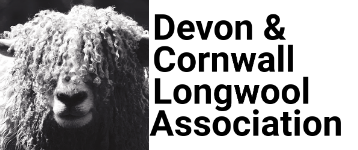Warning: Attempt to read property "post_content" on null in /var/www/vhosts/devonandcornwallflockbook.co.uk/httpdocs/cms/wp-includes/post-template.php on line 298
About the Breed
> Click here to view the breed standard

The Devon and Cornwall Longwool is a hardy sheep. They are easy to care for; being quiet and easy to gather when needed. These sheep are content and tend to stay within the boundaries of fields.
The Devon and Cornwall Longwool sheep is a dual purpose animal suitable for smallholders and all farming systems.
These sheep have good food conversion, growing well on grass and roots. It is capable of producing finished lambs of all weights from 18kg to 25kg and over.
When crossed with the British Milk Sheep (for example) these sheep are capable of great longevity. A 200 lambing percentage is possible when crossed with a terminal sire whilst maintaining its wool quality and quietness.

The Devon and Cornwall Longwool sheep produces a very heavy fleece of good quality wool. From ewes the average clip can weigh 7-8kgs and from rams it can weigh in excess of 15kgs.
This wool is attractive to spinners for weaving rugs. It can also be used for dolls hair, needle felting and to create a variety of home furnishings.
Breed history
The Devon and Cornwall Longwool flock Book Association was formed on 1st January 1977 following the amalgamation of the South Devon Flock Book association and the Devon Longwool Sheep Breeder’s Society.

Although the breed has been in existence for well over 100 years in the West country, the former breeds were slightly different in stature, especially in the early 1900’s. The bigger South Devon was found mainly in South Devon, East and south Cornwall. The smaller Devon Longwool was mainly in North Cornwall, North Devon and South Somerset. However, the breeds over the past few decades have become much more similar, to the extent that the amalgamation is both desirable and practical for all breeders.
This breed is well suited to varying climatic and topographical conditions in and outside the Westcountry. It is an easy grazer, docile with no need for elaborate fencing. They thrive on grass and fodder crops.
The versatility of the breed can be exemplified in many ways both when kept pure and crossed.
- Keeping a pure flock for breeding replacements
- Ewes being crossed with any down ram to produce early fat lambs
- Crossed with Dorset Horn to produce a ewe that will lamb out of season
- Crossed with Blue Faced Leicester of milk sheep to produce half-bred ewes which not only give more lambs per ewe but lambs that finish early at markets weights.

